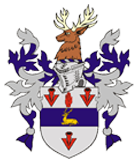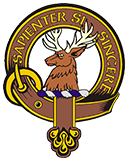Battles of Invernhaven And Perth – 1300s
Allison holds to his version, but does acknowledge that some details in naming conventions may present a few uncertainties, and that “Kay” and “Quehle” could indeed refer to the same clans he takes as Chattan and Cameron. To further complicate matters, the NTS interpretive sign at the North Inch claims that the battle involved the Clans Kay and Chattan [photo insert: Perth Sign-close up]. The name Quehle has been interpreted as an early form or derivation of Cameron. However, there are sources that claim the Clan Quehle, a clan in its own right, was eradicated before the 16th century. Unfortunately, there is no reliable information regarding Clan Quehle other than that it existed at one point. Still, this does present doubt that the names Cameron and Quehle could have been associated since the Clan Cameron is, to this day, strong in number around the globe. The name Kay, however, has been more problematic.
The interpretive sign lends weight to the presence of a Clan Kay at the Battle of the North Inch because of the recognized and respected authority of the NTS. So, this is likely to go uncontested by those who have little or no investment in the specific history. Further, some historians claim that the name “Kay” is actually a derivative of the name “Dhai” because the Gaelic pronunciation of the two words is virtually identical. 17 Add to this the presence of the sept MacKay in our associated Davidson names, and there is reason to believe the names are the same. Thus, one could assume – and obviously many have for some time – that it is the Clan Dhai, or Davidson, whose ancestors fought and lost at the North Inch. In fact, if Scott, a national hero, wrote about it, NTS posted a sign, and authorities claim a Dhai-Kay connection, how can we doubt?!
Again, using Allison’s logical and near seamless timeline to view the details, we can remove uncertainty for the most part. Let us remember that although the NTS posted the interpretation of the North inch battle and do not openly refute the names of the clans contained therein, it is also their research that more solidly places the Clans Chattan and Cameron on opposing ends of the field. Ongoing strife – documented and reliably recounted – between the two clans would have caused a “scene” on a more national front, and would have warranted intervention by the government of the day. The feud continued after 1396, and involved the same players for many of the same reasons. Unless we ignore history and the facts it presents on its own, and unless we succumb to the “fall-back narrative” I’ve described, it is hard to believe it was other than Clan Chattan and Clan Cameron who faced each other on that September morning. 18
Let’s also recall that we have seen that the Davidsons were not in any shape to do battle with a larger clan – and especially not a confederation of clans – and that our overall import at the time was negligible. Again, probably the MacPhersons alone, certainly the MacIntoshes singly, and definitely Clan Chattan as a whole could have “set our clan straight” without a word needing to reach the King. As for the “Dhai-Kay” connection, let’s also remember that there was a very powerful clan by the name of MacKay who were present at the time. Clan Mackay was and is very large, and was, at the time, very important politically. If a “Kay” would have warranted the attention of the King, it would have been the Mac-Kays. However, there is no evidence whatsoever that they were involved in the Battle of the North Inch, and certainly none that they had any quarrel with the Davidsons, MacIntoshes, the Clan Chattan as a whole, or even Clan Cameron. Therefore, we should remove them from candidacy. Where a “Dhai-Kay” connection is apparent is in a coming together of families. The name MacKay, as stated earlier, is an associate name of Clan Davidson. There is thought that this was a small element of the larger Clan MacKay who came under Davidson protection sometime in the early 13th century. However, most historians believe that these MacKays were really MacDhais originally, and that this was a naming error caused by like pronunciation, possibly leading later to the propagation by those holding to the argument (aided inadvertently by Scott) that it was the Clan Dhai at the battle. Again, it is more than likely that Davidsons were involved in the North Inch battle as a contingent of the Clan Chattan. There is also support for claims that at least one of the 11 left standing at the end of the battle was one of our own. Once again, however, I believe we can logically and reasonably put to rest the notion that the Davidsons were the other major player at the North Inch.

